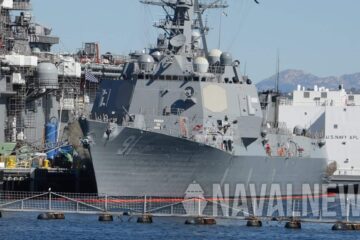The U.S. Navy briefed industry and media on Wednesday about the progress and status of the service’s unmanned surface vessel (USV) efforts.
The briefing, which was held by Captain Scot Searles, the program manager of the Unmanned Maritime Systems Program Office (PMS 406), went over the status and recent experiences with propulsion and power elements that will inform the US Navy’s Large Unmanned Surface Vessel (LUSV) effort.
Searles told industry that Fincantieri Marinette Marine became the second vendor to complete a 30-day propulsion, electrical generation and distribution system test.
The demonstration, which was mandated by the 2021 National Defense Authorization Act, requires that the propulsion equipment be run for 30 days without human intervention. Searles went into further details about that endurance test, stating that “It doesn’t have to be on for 30 days. It can start and stop, but nobody can touch it”
Bollinger Shipyards was the first vendor to complete the demonstration late last month. Searle also added that two other vendors were close to completing these tests.
“We also have two more vendors that are over 85% Complete with their 30 day test and we expect to finish those in the next couple of weeks” Searles said.
Clearing the 30-day test, which occurred at a land-based test site at Carter Machinery down in Chesapeake, Virginia, is a prerequisite for moving forward with the LUSV.
Last year, the Naval Sea Systems Command (NAVSEA) released a Request For Information (RFI) notice seeking industry feedback on draft specifications for the LUSV.
“Every piece of equipment that goes through that test is now on the yes list for LUSV,” explained Searles. “We are trying to get that list as full and complete as we can in advance of RFP development, in advance of issuing the RFP.”
The U.S. Navy expects to award a Request For Proposal (RFP) covering the Detailed Design and Construction (DD&C) of the LUSV in the second quarter of 2024.
The program office is trying to certify several different engine types of varying sizes, alongside several different diesel generators that would be suitable for LUSV.
However, vendors don’t necessarily have to stick to equipment tested by the government. They can also do their own 30-day testing on various pieces of equipment. However they must inform the program office ahead of testing and coordinate the testing with them.
About the Large Unmanned Surface Vessel (LUSV)
The Large Unmanned Surface Vessel (LUSV) will be a class of optionally or lightly manned vessels that are between 200 to 300 feet (60 to 91 meters) in length and 1,000 to 2,000 tons in displacement.
According to the U.S. Navy’s latest budget documents, the vessels will, “support Distributed Maritime Operations (DMO) and provide the Joint Force with an adjunct missile magazine capability and capacity.”
The vessels will be equipped with missile launchers to carry out their primary mission, which centers around Anti-Surface Warfare (ASuW) and Strike Warfare (STW).
They will operate aggregated with Carrier Strike Groups (CSG), Expeditionary Strike Groups (ESG), Surface Action Groups (SAG), and individual manned combatants. Where their extra missiles will act as adjunct magazines.






